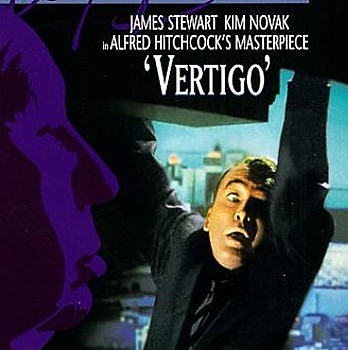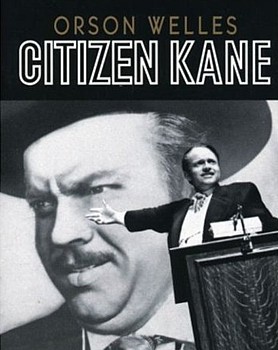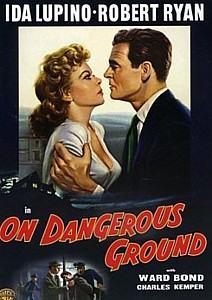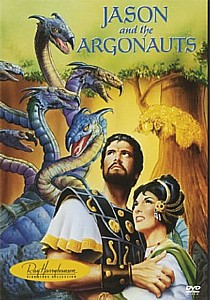THE COMPLETE FILM CREDITS OF BERNARD HERRMANN

"Vertigo" and Bernard Herrmann uses
music to remind him of it for the next two hours.
Bernard Herrmann's long career involved him in a wide variety of projects, including many TV series and made-for-television movies. This list deals only with his feature films shown first in movie theaters. Excluded also are films that incorporated earlier Herrmann compositions after his death.
1. (1941) Herrmann's debut film is widely regarded as the best in American movie history. He was also its conductor, music arranger and orchestrator, but is uncredited in the film for those contributions.
2. (1941) This film is often shown on TV under the title "All That Money Can Buy."
3. (1942) This Orson Welles version of the Booth Tarkington novel was the director's follow-up to "Citizen Kane."
4. (1944) Once again Herrmann worked with Welles, who didn't direct the picture, but played the leading male role.

career with the score for the
film most critics consider
the best ever made in America
...Orson Welles'"Citizen Kane."
5. (1944) This was Herrmann's first "B" picture, an entry in the RKO detective series starring Tom Conway.
6. (1945) This atmospheric horror film starring Laird Cregar has just been digitally restored and released on DVD in a "Fox Horror Classics" boxed set.
7. (1946) This was Herrmann's first immensely popular movie, starring Irene Dunne and Rex Harrison in the true story that later inspired the musical "The King and I" and a non-musical 1999 remake starring Jodie Foster and Chow Yun-Fat.
8. (1947) This popular romantic ghost story starring Rex Harrison and Gene Tierney helped keep Herrmann in the genre of haunting stories.
9. (1948) This was another haunting love story starring Jennifer Jones as an apparition Joseph Cotten falls in love with rather hopelessly.
10. (1951) Director Robert Wise, who was a film editor on "Citizen Kane" while Herrmann was composing its music, called upon his old colleague to compose the moving score for this immortal sci-fi film about a "good" alien who comes to Earth.

his many scores was the
one he did for this 1952
film noir...
"On Dangerous Ground."
11. (1952) This dark film by Nicholas Ray was Herrmann's first real voyage into film noir and he reportedly considered it his favorite score.
12. (1952) This is a highly regarded World War II spy thriller starring James Mason as a Nazi spy working in England.
13. (1952) When Herrmann was given the job of scoring this Hemingway story for stars Gregory Peck, Susan Hayward and Ava Gardner in a big budget 20th Century Fox production, it was clear he was highly favored at the studio.
14. (1953) Fox kept Herrmann in Africa shooting this true story rather than put him to work on 3-D movies in vogue that year.
15. (1953) was a CinemaScope underwater adventure starring Robert Wagner as a Greek-American sponge diver. Hermann's score has that special waterlogged quality we associate with undersea epics.
16. (1953) This adventure saga starring Tyrone Power was one of Fox's first films in the widescreen CinemaScope process and Herrmann gave it a rousing score.
17. (1954) was Herrmann's first western, a genre he quickly took to with high energy, even scoring several episodes of TV westerns like "Rawhide," "Have Gun, Will Travel," "Gunsmoke" and "The Virginian." This film has just been released in a DVD boxed set of "Fox Western Classics."
18. (1954) was a big budget flop that was supposed to star Marlon Brando, then the screen's most sought after leading man, but wound up starring unknown Edmund Purdom. This started Herrmann on a long run of exotic music for films in ancient or mythical worlds.
19. (1955) was a box office turkey, but it's an exceptional film based on the life of 19th century stage actor Edwin Booth (Richard Burton) and the hell he went through when his brother John Wilkes Booth (John Derek) assassinated Pres. Abraham Lincoln.
20. (1955) took Hermann away from Fox studios and put him under the aegis of producer-star Burt Lancaster for this outdoor saga. It's a lively and much-admired score.
21. (1955). How odd that this atypical Alfred Hitchcock comedy/mystery marked Herrmann's first collaboration with Hitchcock. It's all about what happens when a little boy (Jerry Mathers, later the star of TV's "Leave It To Beaver") finds a corpse in the woods.
22. (1956) was one of Fox's prestige pictures of the year, starring Gregory Peck as a Madison Avenue executive questioning the direction of his life in changing times.
23. (1956) was Hermann's second Hitchcock feature, the only time Hitch ever remade one of his own films. However, do not credit (or blame) Herrmann for the Oscar-winning hit song Doris Day sings in the film--"Que Sera, Sera." That was the work of Jay Livingston and Ray Evans.
24. (1956) was another atypical Hitchcock film, a police procedural based on the true story of a man (Henry Fonda) falsely accused of a crime and done in very quasi-documentary style. Because Fonda plays a jazz musician, Herrmann's score has an uncharacteristic jazz motif.
25. (1957) was a somber drama about drug addiction, based on a Broadway play and Herrmann's score was equally heavy.
26. (1958). This is the classic Alfred Hitchcock suspense thriller and Herrmann's first really great score for a Hitchcock film.
27. (1958) The little-seen movie version of Norman Mailer's first and best novel about the war in the Pacific. It was made for RKO just before the studio collapsed, so its unreleased films were released later by other studios. My memory is that this was a much better Herrmann score than the movie dsserved.

acclaimed fantasy
scores Herrmann did
for films that also
used special animation
effects by Ray Harryhausen.
28. (1958) was the first of many marvelous fantasy films blending Herrmann's exotic scores with the stop-motion animation of Ray Harryhausen.
29. (1959). Herrmann produced another great and memorable score for Hitchcock, this time in a fast-paced thriller that ends with Cary Grant and Eva Marie Saint scrambling for their lives on the faces on Mount Rushmore.
30. (1959). This is the now extremely dated adaptation of the Broadway play about a teen couple trying to cope with the girl's pregnancy. To see how much times have changed, compare this with last year's "Juno." I have no memory of Herrmann's score at all.
31. (1959) put Hermann to work once more on a fantasy-laced score, this time for the Jules Verne story of explorers who penetrate a world inside the Earth, among them pop singer Pat Boone.
32. (1960) is Herrmann's best-known score and certainly one of his most effective for any Hitchcock film. His shrieking violins make you feel the knife thrusts when Janet Leigh takes her famous shower. Even if Hitch doesn't really let you see the blade sinking in, Herrmann's notes make you think you're feeling the pain.
33." (1960) brought Herrmann back to work on a film lifted by Ray Harryhausen's magical animation effects, retelling the story of "Gulliver's Travels."
34. (1961) again teams Harryhausen and Herrmann for an exciting extension of Jules Verne's sequel to "20,000 Leagues Under the Sea."
35. (1962) broke Herrmann away from his thrillers and fantasies long enough for him to complete a poignant, romantic score for F. Scott Fitzgerald's tragic love story.
36. (1962) contains Herrmann's best score for a thriller not made by Hitchcock. The music is so essential to the pulse-pounding suspense of this film that director Martin Scorsese re-used it for his 1991 remake with the help of composer Elmer Bernstein.
37. (1963) is another masterful score by Herrmann for a Hitchcock film, this time using musical notes to simulate the sounds of the bird world.
38. (1963) was Herrmann's final collaboration with animator Ray Harryhausen and one of his most exotic scores.
39. (1964) brings Herrmann back into the Hitchcock mode, this time using subtle musical strokes to underscore the story of a mysterious girl who's always pretending to be someone else.
40. (1965) was a major detour for Herrmann into a B-movie adaptation of a Betty Smith novel, put together to capitalize on the popularity of TV's "Dr. Kildare," Richard Chamberlain, who plays a young lawyer romancing Yvette Mimieux.
41. (1966) was Francois Truffaut's European-made film from Ray Bradbury's novel about a future in which all books are banned, directed in English by Truffaut and starring Julie Christie.
42. (1968) reunited Truffaut and Herrmann with this French adaptation of the Cornell Woolrich noir novel about a bride who takes revenge on the men who killed her husband-to-be on their wedding day. Truffaut, a devotee of Hitchcock, did the film in Hitchcock style as a tribute to the master, so he naturally wanted the appropriately creepy score from Herrmann--and got it.
43. (1968) was familiar territory for Herrmann: A mother-dominated young man becomes obsessed with a young woman he meets and, when she rejects him, goes on a killing spree.
44. (1969) was a European-made film about the Nazi invasion of Yugoslavia during World War II.
45. (1971) is a British film about a creepy handyman and his impact on the lives of two country women.
46. (1972) is British director Sidney Gilliat's film from the Agatha Christie novel about a rich girl (Hayley Mills) who marries a chauffeur and realizes she's in nightmare territory.
47. (1973) was a horror thriller directed by Brian DePalma, another Hitchcock disciple, who wanted Herrmann to give him a suspenseful score like he might give Hitchcock. Result: One of Hermann's best scores in years.
48. (1974) was Herrmann's first voyage into low-budget schlock horror exploitation cinema--a eerily effective score for Larry Cohen's repulsive tale of a monster baby.
49. (1976) was Herrmann's last really great score, capturing the sleazy world of psychotic taxi driver Robert DeNiro as rendered by director Martin Scorsese.
50. (1976) was Herrmann's last collaboration with director Brian DePalma, whose goal here obviously was to do a close knock-off of Hitchcock's "Vertigo" as Cliff Robertson finds his missing wife "reborn" in the guise of Genevieve Bujold. Herrmann's score is quite good and, no surprise, quite reminiscent of his "Vertigo" score.
